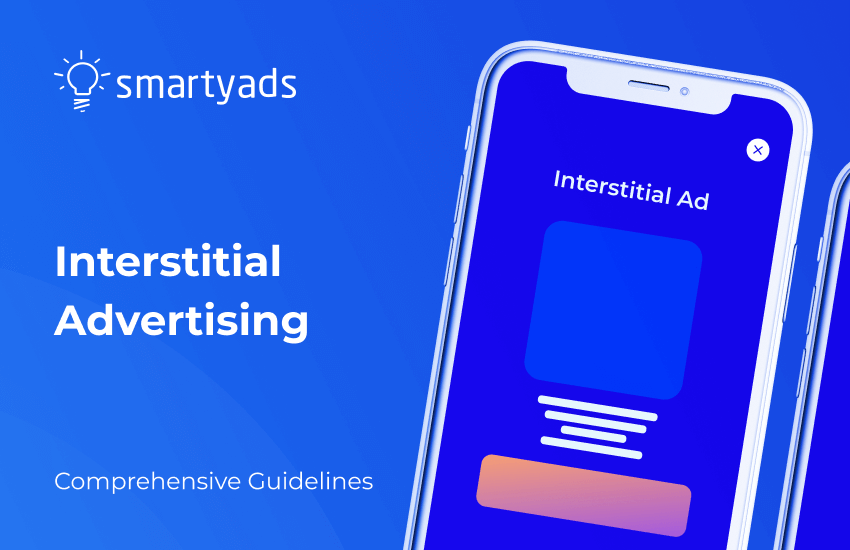Nowadays, interstitial ads belong to the most popular ad formats. Interstitial video ads and display interstitial ads are chosen by advertisers and mobile marketers around the world as they effectively drive user clicks and engagement.
If properly used and implemented, this ad format can help to increase downloads and revenue.
Let's take a closer look at best practices for interstitial ads and discover how this ad type differs from other ad formats and how it can complement your media mix. Also, let's see how the interstitial ad works on mobile sites and desktops.
What are interstitial ads?
So, what is interstitial ad? For starters, it's worth mentioning that there are display and mobile interstitial ads.
Mobile interstitial ads
Interstitial ads are full-screen ad formats that cover the interface of an app. They are usually displayed at natural app transition points in the flow of an app, like pausing a game or between different activities. Interstitial mobile ad - how it works (see below).
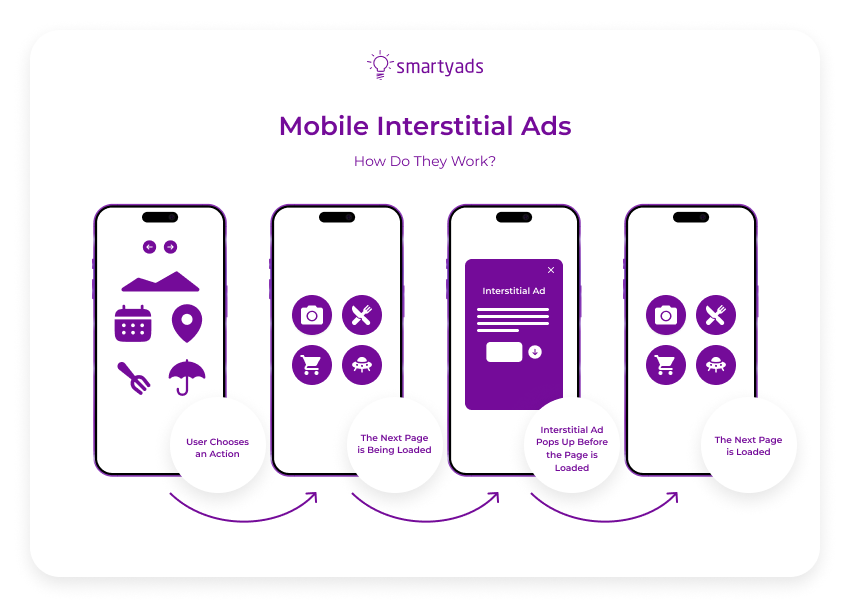
The main difference between other types of ads and interstitial ads is that the latter cover the screen, which makes them catchier and more effective. Often, they take the form of expandable ads.
Interstitial ad example for mobile
Let's get some example of interstitial advertising. Here are some examples of ads — interstitial ad (left), pop-up ad (middle), and banner ad (right): Interstitial ads mobile formats will be described further.
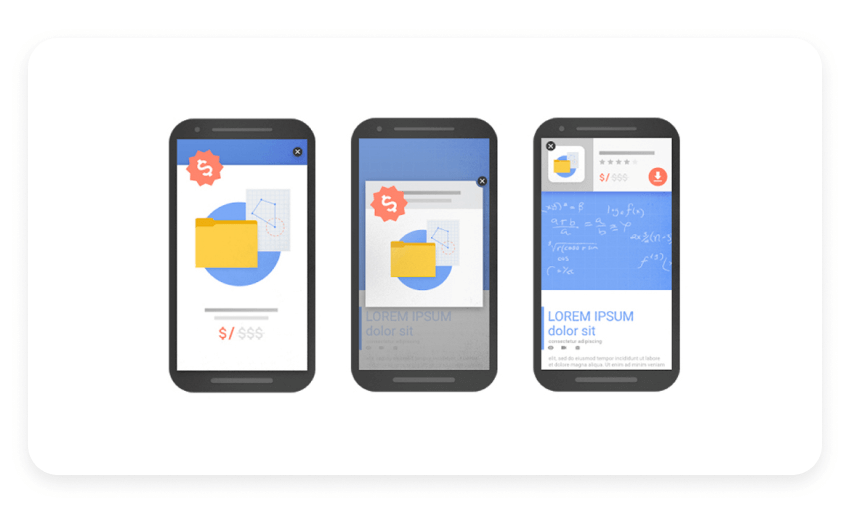
Desktop interstitial ads
The desktop interstitial ad format is still the same full-screen unit that typically appears on mobile devices. However, this time interstitial adverts are displayed on desktop gadgets like PC.
For example, Google Ads also supports such full-screen ads. Although the interstitial ad was retired by Google long ago, in 2021, it made a comeback.
The new interstitial ads from Google run between the page views and not when the user first lands on the web page. For that reason, it doesn't affect SEO so much.
Also, those ads are no longer seen as intrusive advertising (previously, they triggered ad blockers). Now, the user has the option to close the interstitial ad right away by using an interstitial ad exit button; this eliminates the case of poor user experience.
Advertisers usually place interstitial ads at natural transition points. For example, when the user navigates the website and transitions to the next page, the interstitial ad is prepared to pop up on the screen.
Interstitial ad example for desktop
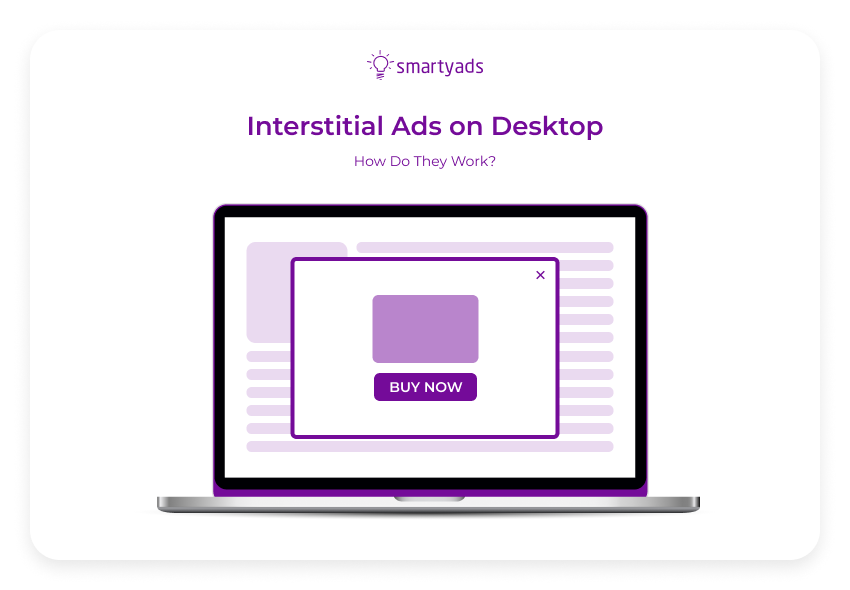
As you can see, the interstitial ads on the desktop screen can come in the form of banner ads that occupy most of the screen. Those can be static ads or banners with rich media elements.
Such full-screen ads effectively fight banner blindness and raise user engagement. What about ad diversity, though? Are interstitial ads work only as banner ads?
Choosing an interstitial ad type
Not all interstitials are the same. An interstitial ad type or format can be static or dynamic. Usually, advertisers integrate interstitial ads in mobile apps in the following formats: display ones and video interstitials.
Let's review all of those to discover what interstitial ads offer to advertisers these days.
Interstitial video ads
Videos are popular mobile ad formats, which is why they are also frequently used as interstitials. A few storytelling tools can be as effective and impactful as videos, especially in games.
Video interstitial ads also can have so-called end cards — the banners that appear on the user screen when they finish the advertising video. These cards normally contain a call to action.
Rewarded video interstitials allow gamers to receive in-game bonuses in exchange for ad-watching.
For this reason, this format is the most wanted in the digital advertising world as it provides users value. It has to have an exit ad button so that the user can decide whether to watch the ad or close it.
Rewarded interstitial example
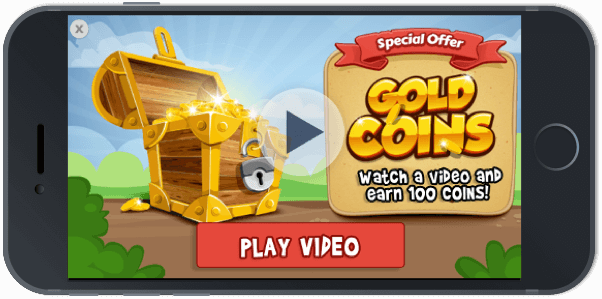
Playable interstitial ads are also a good choice for advertisers. Playable ads pop up on the user interface when they are playing the mobile game or immediately upon app load. Those can be Android full-screen ads or units suitable for IOS (interstitial ads example Android is below).
Playable interstitial ads are offering the users to try the mini-game right inside the advertising video. That's why video interstitials are very engaging and generate great ad revenue.
Playable interstitial ad example
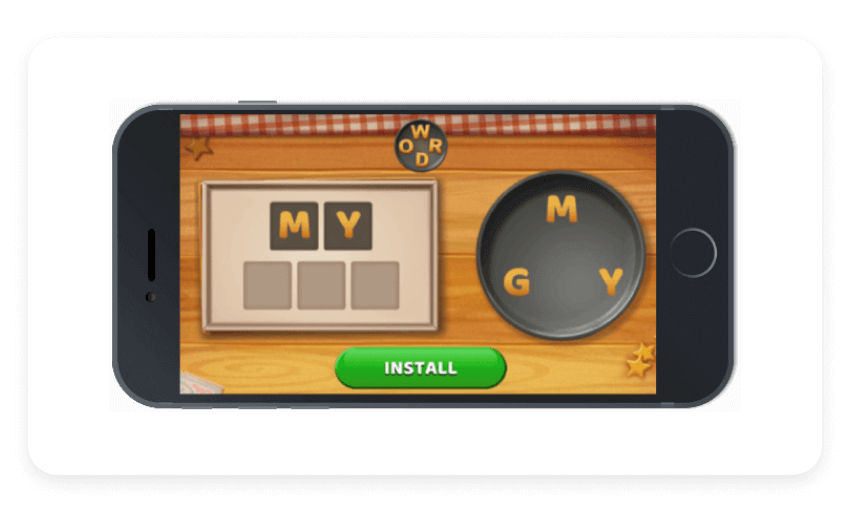
Display interstitial ads
Interstitial banner ads are the most popular format. Implementing interstitial ads of this kind is fairly easy — unlike rewarded and playable ads, banner ads can be supported in all environments. The ad unit can be displayed on a mobile site, in a mobile app, in mobile search results, on a desktop, CTV, and so on. Banners normally suit the majority of operating system guidelines.
Interactive GIFs can also be pretty universal for placing on a mobile site as this interstitial ad is interactive enough (which fights banner blindness). Still, it won't be difficult to design and support.
Interactive GIF example
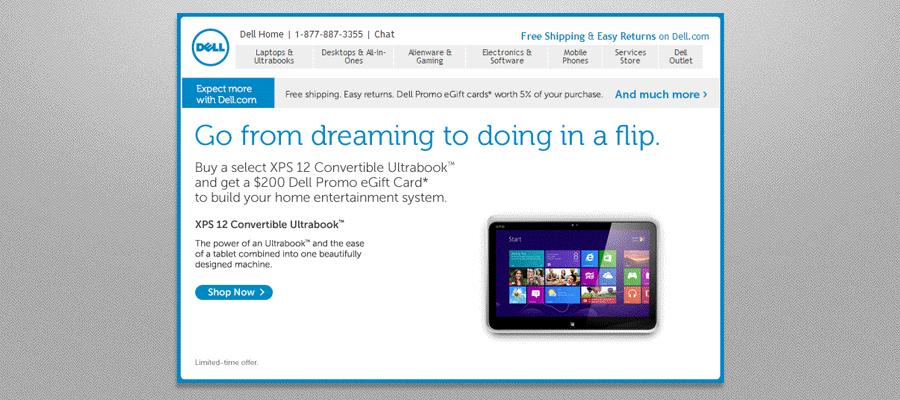
image credit: advertisement.com
Pop-up ads can work as interstitial ads too. They should be implemented seamlessly; otherwise, the ad can annoy users and leads to lower user retention. Pop-ups are popular on desktops. At the same time, it's worth remembering that those pop-ups on mobile deliver a bad user experience, which is why they are penalized by Google.
Pop-up ads example
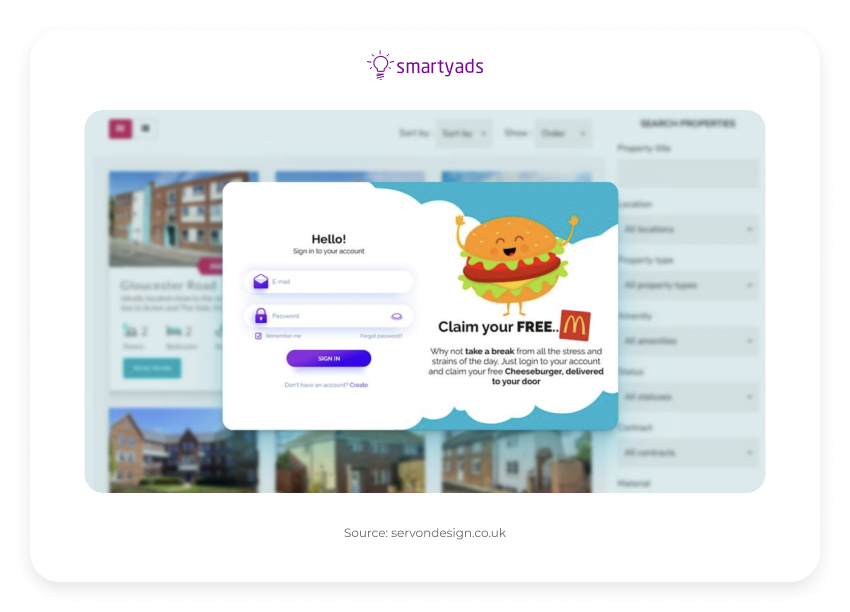
Why interstitials?
The ultimate purpose of an interstitial ad is to deliver unparalleled viewability and click-through rates; as a result, they have much better ad revenue.
Interstitial ads pay really great dividends to advertisers in terms of performance.
Interstitial ads have great performance:
- They bring 18x higher click-through rates than banners;
- 63% of casual/hyper-casual app developers use at least one interstitial ad format;
- In 2022, the United States had the highest effective cost-per-mille (eCPM) for in-app full-screen interstitials on Android ($10.45). Australia ranked second (eCPM $9.10), and South Korea ranked third (eCPM $7).
Nowadays, developers and marketers start using interstitial ads more often because of their high impression rate to increase downloads and revenue.
Pinterest and Airbnb Experience
After adding interstitial ads to their media mix, world-famous companies have seen great increases. Pinterest, Airbnb, and others started optimizing interstitials and showed excellent results (their increases are 100% and 300%, respectively).
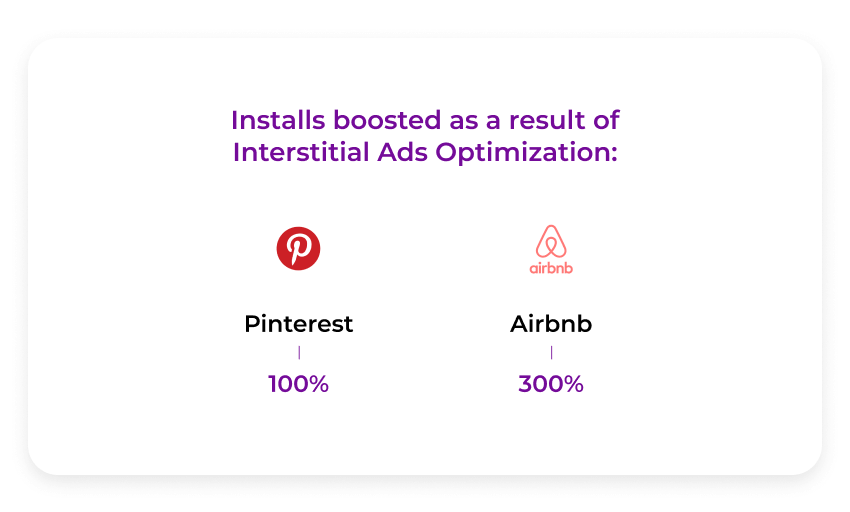
There are several reasons why interstitials should be used:
- Large sizes = large impressions on users;
- High impression rates = high click-through rates;
- Increased click-through rates = increased conversion rates.
To make your interstitials effective and to see good results read some recommendations below. These best practices will help you to increase traffic and boost conversions.
Are interstitial ads most popular in mobile games?
Mobile games do not have broad ad diversity because creatives should follow operating system rules, which sometimes is hard to achieve.
At the same time, while advertising in mobile apps and games in particular, advertisers avoid the problem with accidental clicks and ad blocker software. Likewise, media buyers do not have to worry that their ads appear on a web page with too many ads — the mobile app displays one ad at a time.
Hyper-casual mobile games, word games, and arcades normally base their earnings on advertising revenue; that's why they are best for placing interstitial ads.
How to place interstitial ads in games?
According to Unity data, two ads per minute is the optimal number of impressions for hyper-casual games, including interstitial ads and other digital ad formats. Plus, this game genre also churns quite quickly, so one should start serving the interstitial ads in the app from the first day the user opens the game.
At the same time, it will be better to wait one or two weeks before serving interstitial ads when we say about such game genres as casual, mid, and hardcore. Why? Because gamers in them normally have longer LTVs.
Interstitial ads' best practices
Creating a smooth flow
Keep in mind that interstitial ads are best suited for linear user experiences. It means that the start and stop points of the ad should be clear, and the ad should complement the natural flow of user engagement. If you present an ad at an expected break or user-initiated pause, you will not disrupt your user experience. Plus, you will avoid accidental clicks.
It is recommended to let them appear before the break page (the page that usually asks the user to tap a continue (or next) button to proceed). If ads appear immediately after this page, it will lead to accidental ad clicks and hurt your conversion rate.
Another important thing is the memorability of your interstitial creative. Make sure you capture your audience's attention with an advertising design that stands out and encourages clicks. Most importantly, before you choose between 'landscape' or 'portrait' creative orientation, think of the environment it will appear in and whether rendering will be correct on all devices.
Consider timing and frequency
One of the main reasons why people delete apps is intrusive ads. Do not bombard users with interstitials. It may be interesting to increase the frequency, but the user experience can be corrupted; if users are interrupted by ads, they can't enjoy the app. Insert a delay (or "loading") screen before your interstitial ad. It will prevent your user from tapping hundred times on the ad.
Optimize the creative
Slow or unresponsive graphics is one of the most annoying problems that users can have while watching an interstitial ad. For this reason, always make sure your interstitial ads are optimized for the environment (mobile, in-app, desktop). It's always a good practice to make them lightweight.
Direct targeted traffic to dedicated post-click landing pages
Make sure that the interstitial ads you show are understandable and readable and that your ad offer can be easily accessed by sending prospects directly to a dedicated post-click landing page instead of your website. Post-click landing pages help to convert prospects into leads.
Build your ad campaign with SmartyAds DSP to derive maximum benefit from interstitials. It is omnichannel media-buying technology that integrates deeply with the world's trusted ad networks.
The omnichannel approach helps advertisers reach their customers in Mobile Web, In-App, Desktop, and CTV ecosystems at the right time and screen. ML and AI algorithms provide automated bidding, optimization, and reporting at the platform's core.
Why SmartyAds DSP?
Let us present some core features that distinguish SmartyAds DSP from other ad platforms. Here they are:
- Cost-efficiency
This platform automates media-buying activities, reducing advertising costs with dynamic bid optimization. It drives high ROI and conversions instantly.
- Brand-safety
With SmartyAds DSP, you will have total brand-image protection, 100% human-viewable traffic from trusted partners, and 24/7 traffic purity.
- Omnichannel reach
SmartyAds DSP helps align messaging, goals, objectives, and creative formats across each channel and device a particular customer uses. It can be desktop, in-app, mobile, or CTV.
This platform helps advertisers run AI-powered programmatic ad campaigns across channels, formats, geos, and business verticals with a minimum budget but maximum ROI achieved through narrow targeting and programmatic optimization.
SmartyAds DSP opens a gateway to such opportunities as advertising with banners, interstitials, mobile display, in-banner video, and rich media ad formats. You can serve banner ads in various sizes and configurations, including IAB Leaderboard, Skyscraper, and Billboard.
If you want to maximize purchasing strengths with cross-channel traffic, memorable ad formats, and ultimately transparent advertising ecosystems, try DSP now. Just register, and you will watch it in action.
Why SmartyAds SSP?
SmartyAds SSP helps web publishers and app developers to have full transparency and complete control over ad inventory at all levels. Using the SSP platform, you can sell your ad space to premium buyers at private marketplaces and monetize unsold inventory via RTB auctions.
The following are distinctive features of SmartyAds SSP:
- Generating the best possible CPM
SmartyAds Supply-Side Platform is built on machine learning technology that adapts to real-time market conditions. You can determine your inventory pricing using the Floor Price feature that will calculate the ideal value for every unique impression and prevent disadvantageous deals.
- Driving revenue with Header Bidding
Header Bidding in SmartyAds Supply-Side Platform allows publishers to access greater sources of demand and gain greater exposure. You can offer your ad inventory to a multitude of demand partners simultaneously and initiate powerful competition.
- Mobile advertising and easy integration
SmartyAds' lightweight SDK is a flexible solution for mobile publishers to monetize their in-app advertising space through interstitial ads.
SmartyAds SDK solution works seamlessly in a speed-sensitive mobile environment, delivering relevant ads across all mobile supply sources without interfering with user experience.
With SmartyAds SSP, digital publishers can offer high-quality ads across screens, operating systems, and channels.
They can choose the best-performing ads for their audiences among the display, banner, native, text, video, mobile, and innovative ad formats that would look great on any device.
Publishers can use proprietary data to manage multiple relationships across desktop, mobile, native, and video — everything from a single, all-in-one SSP platform.
They have control over the direct and indirect inventory using price floors, approving certain demand partners, and blacklisting specific ads from being displayed on the website or app.
